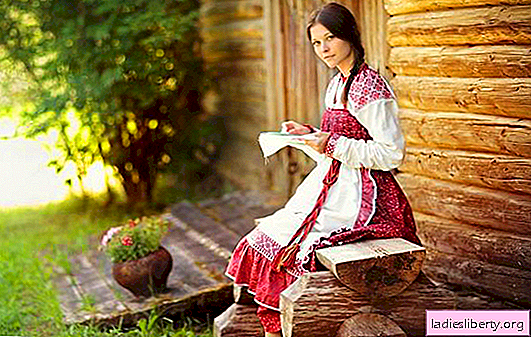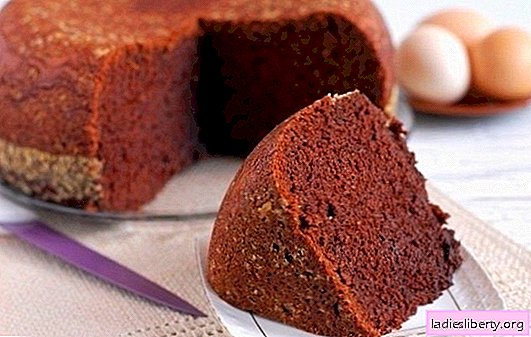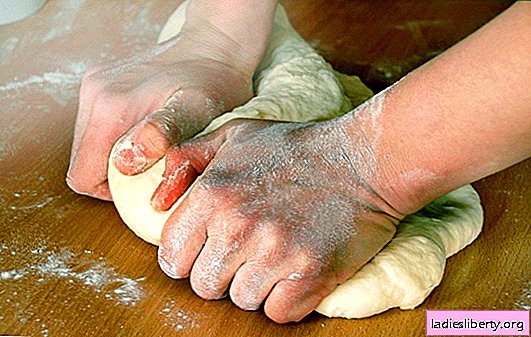
Blueberries are successfully grown by summer residents in many regions - even in those where cold long winters.
The plant is relatively unpretentious and with proper care gives consistently high yields of delicious healthy berries every season. The bush will begin to bear fruit already 3-4 years after planting on the site.
Under favorable conditions, the plant will live for several decades!
Confusion often arises - blueberries are called blueberries. The berries are the same in color, but differ in taste and properties. Try the fruits of the plant. If they leave an “ink” mark on the tongue, in front of you is a bush of blueberries. Blueberry juice does not have such a coloring effect.
Start by choosing a variety
Many varieties of garden blueberries have been bred for cultivation on personal plots. When choosing a suitable species, focus on the timing of fruit ripening. The plant is:
• Early ripening. Delicious berries can be collected from the bush by the beginning of July. Popular varieties - Duke, Erliblyu, Stanley, Bluetta.
• Mid-season. Fruits begin to ripen towards the end of July. Popular varieties are Elizabeth, Bluecrop, Blyudzhey, Patriot, Rankosas.
• Late ripening. Berries can be picked only by the end of summer. Representatives of this species under adverse climatic conditions do not have time to ripen even in the south. Therefore, do not settle too many late blueberries on your plot, otherwise, you may be disappointed as a result. Popular varieties are Eliot, Dorrow, Jersey, Gorbert.
There are species of blueberries short, medium and tall. Tall plants in the north take root poorly. But medium-sized varieties (Northland, Weymouth, Bluetta, Northble) show the best germination and productivity in any climate - They are resistant to colds, pests and diseases.
As for the taste characteristics of berries, it all depends on your personal preferences. Many positive reviews, thanks to large juicy fruits, received grade Blucrop.
Preparation of a site for growing blueberries
Blueberries do not like shady places. If you grow it in such conditions, the berries will be sour. Therefore, select an open area for the new resident of the garden that is not blown by cold winds.
You will have to spend time preparing the beds. Blueberries grow well on peaty-sandy or peaty-loamy soils with a pH of 3.5-4.5. It is better if before planting a couple of years other cultures did not grow here. Blueberry roots have a filamentous, fibrous structure with a special fungus (mycorase) at the end, which will not develop on neutral and alkaline soils. It is important to ensure good drainage on the site - garden blueberries will not tolerate waterlogging. You can acidify the soil with citric or oxalic acid - 3 tsp per bucket of water.
When preparing the planting holes should be created for seedlings optimal conditions for growth:
• Prepare a hole measuring 60 * 60 cm and a depth of 50-60 cm. Loosen the walls and bottom of the hole a little to ensure good drainage of excess moisture.
• Pour a nutritious “substrate” into the pit - 40-60 g of sulfur, peat, sawdust, shavings, needles, sand.
• Mix and compact the mixture.

Blueberry Landing Pit
Do not add manure and ash to the planting pit - they are contraindicated in blueberries! The distance between the bushes is 0.7-1.2 m.
Planting blueberry seedlings
Not all gardeners “dare” to grow blueberries from seeds - the risks are great that planting material will never sprout. This technique is more often used in specialized nurseries by breeders. For a beginner, another option is more suitable - planting blueberries with a seedling.
Buy seedlings either from experienced gardeners in whom blueberries have been yielding good crops for years, or in nurseries. Pay attention to the planting material itself - it should not have traces of diseases and damage by insects. Instances with a closed root system - in containers or pots - take root well. Already choose a suitable seedling? Now proceed to the correct landing.

Blueberry seedling, ready for planting on open ground
Preferable spring planting blueberries. Work can be carried out in the summer, but the risks increase that before the onset of frost, the seedling does not have time to take root. The landing scheme is as follows:
• Lower the container with the tree just before planting for 10-15 minutes into the water.
• Carefully, so as not to damage the roots, mash the lump of the substrate in which the seedling was sold. If the roots tightly braided the earth, try to straighten them.
• Deepen the plant into the ground by 5-7 cm. You can focus on the level at which it was planted in a pot.
• Water the ground and mulch the trunk area. It is better to use sawdust for these purposes.

Blueberry Planting Pattern
Next, provide blueberries with care so that it develops normally - the plant will thank you with plentiful harvests of healthy berries.
How to care for blueberries?
Caring for blueberries is practically no different from the rules for growing many other garden crops. The following conditions are important:
• Watering. Moisten the trunks carefully - no gulf allowed. If the water on the site stagnates for more than 2 days, the bush may die. Regular watering is especially important during the flowering period of the plant and the ripening of berries.
• Top dressing. When it takes 2 weeks after planting the seedling, feed the bush with minerals (phosphorus, potassium, nitrogen in a ratio of 2: 1: 1). After fertilizing, trunks should be watered. From the next feeding season, spend in April and June. Organic is better not to abuse!
• Loosening. 2-3 times a season, be sure to plow the soil under the blueberries. The depth of weeding is 6–9 cm. Frequent processing of the beds when caring for the plant is not needed - this can damage the roots.
• Mulching. The mulch layer is 12 cm. This will protect the blueberries from overheating in extreme heat and from freezing in winter. As mulch, you can use sawdust, peat, needles or oak leaves. Often, updating the “protective layer” is not necessary - 1-2 times per season will be enough.
• Pruning. Forming clippings start from the sixth year. Dead branches need to be removed - they take away all the nutrients from the plant. Pruning is done at the beginning of winter and in spring. On the bushes, leave 4 fruiting branches and 4 young shoots. It is better to completely remove the undergrowth in order to prevent thickening of plantings and the development of fungal diseases.

Blueberry pruning
If in winter the temperature does not fall below -23 ... -25 ˚C, blueberry bushes can not be additionally covered. In the north, a nonwoven fabric or a layer of sawdust is used for shelter.

One way to cover blueberries
Blueberry propagation methods
If blueberries have taken root well on your site, you can settle a few more copies here, using planting material from the parent plant. In this case, all the properties of the plant will be transferred to the new bush. The methods are as follows:
• Cuttings. This is the best option, showing good survival results. Gardeners begin harvesting lignified shoots in late autumn or already in winter. The material is wrapped in a bag and stored until the start of the season in a cool, dark place. In April, you need to get the shoots and cut them into cuttings - up to 20 cm long, with an oblique lower cut and a straight upper cut. Planting material is rooted in the substrate - sand and peat (1: 1). Planting can be carried out in a container or in a covered greenhouse. Care is simple - watering several times a week. The cuttings are planted in the ground in September and October.

Rooting cuttings
• Layering. Reproduction by this method begins when the branches are already "falling asleep." The lower shoots of the plant are bent and buried in a nutrient substrate - sand, peat, sawdust. From above they need to be covered with a film to prevent dying. Layers from the bush for transplanting to a permanent place are separated next year in the spring. This period, if the root system has not managed to reach sufficient size, can be increased.

Blueberry propagation by layering
How to protect blueberries from diseases and pests?
Damage to blueberries by diseases and attacks of insect pests is better to prevent than to solve the problems that arise later. Take care of preventative measures. Here's what experienced gardeners advise:
• In early spring, you can carry out a general eradicating treatment - spraying with a 1% solution of polycarbacyl, 1% Bordeaux liquid.
• As soon as greens appear on the branches, spray plants with a 0.2% solution of some fungicide 3 times at intervals of 7-10 days.
• Treat the plant with the same fungicide after harvest.
• Before hibernation, blueberries will not hurt to conduct another eradicating treatment.
Blueberries, if all the rules of agricultural technology are observed, rarely gets sick. But even experienced gardeners are not immune to mistakes. Bushes can affect the following diseases:
• Stem cancer. The disease is caused by a fungus. Brown-red spots are first formed on the branches. Gradually they increase in size, affecting all branches and leaves - this can lead to their complete death. That is why it is so important to respond on time. In order to prevent the appearance of fungus on the plantings, do not plant blueberries close to each other and do not allow waterlogging of the soil. To combat stem cancer, treat the plant with a topsin solution or euparen - several sprays may be required. Remove damaged stems from the bush and burn.
• Gray rot. The causative agent of the disease is a fungus that affects all parts of the plant. Microorganisms spread from the top of the bush to its base. Gray rot is characterized by the appearance of reddish spots on the leaves, shoots and fruits, lightening with time. The fungus can survive the winter in the earth - if you do not start the fight against the disease in the current season, it will continue until the next. They help to cope with the gray rot of spraying with Bordeaux liquid - 2-3 times with an interval of 7-10 days.

Gray rot on a blueberry
• Fetal Moniliosis. A fungal disease that affects all parts of blueberries. It is manifested by the drying out of berries, branches, leaves and flowers. You can cope with the disease with Bordeaux fluid. Be sure to cut off the damaged shoots. Fruits from the affected branches should not be eaten.
• Physalosporosis. The disease forms on young branches - usually closer to the end of summer. First, small reddish spots appear on the branches, which next season “outgrow” into wide wounds. Cutting off the damaged parts of the plant does not greatly affect the spread of physalosporosis. It is better to spray blueberries with topsin, Bordeaux liquid or fundozole after harvesting.
• Leaf spotting. Many small spots of white, grayish or brown color appear on blueberry leaves. Damaged leaves fall over time, which affects the fruiting of the bush. Collect and burn foliage so that the disease does not spread to neighboring plantings, change the mulch. In the fight against white leaf spotting, Bordeaux fluid will help.
Of viral diseases, blueberries in the garden can be affected filamentous branches, necrotic spotting, mosaic, red annular spotting. It is very difficult to fight such "misfortunes" - as a rule, you have to completely remove the plant from the beds so that the disease does not spread to neighboring crops.
Pests of blueberries do not really favor, which will be a big advantage for the gardener.
Take care not to hide in the foliage silkworm caterpillars. They eat leaves and buds on the shoots, braid the branches with their cobwebs, thereby reducing the yield of specimens.
May cause harm aphids and scale insects. If manual collection of insect pests does not work, you can use chemicals. Spray better after collecting berries. Use quality products as this is a fruit bush.
But birds enjoy blueberries very much. Near plantings, you can put a scarecrow or fence the beds with a grid. It will also be effective to hang shiny ribbons on the branches of blueberries - reflections from them will scare away the birds.











